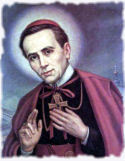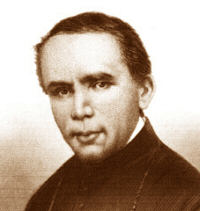Christmas: January 5th
Memorial of St. John Neumann, bishop (USA)
Other Commemorations: St. Edward, King and Confessor (RM)
» Enjoy our Liturgical Seasons series of e-books!
John Nepomucene Neumann was born in Bohemia. While in the seminary he felt a desire to help in the American missions. After coming to the United States he was ordained in New York in 1836. Entering the Congregation of the Most Holy Redeemer, he worked in establishing parishes and parish schools. In 1852 he was consecrated Bishop of Philadelphia and prescribed the Forty Hours devotion.
According to the 1962 Missal of St. John XXIII the Extraordinary Form of the Roman Rite, today is the feast of St. Telesphorus, pope and martyr. According to St. Irenaeus, St. Telesphorus, who governed the Church from 126 to 136 during a period of violent persecution, suffered martyrdom for the faith.
St. John Neumann - Day Twelve John Neumann was born in Bohemia on March 20, 1811. Since he had a great desire to dedicate himself to the American missions, he came to the United States as a cleric and was ordained in New York in 1836 by Bishop Dubois.
John Neumann was born in Bohemia on March 20, 1811. Since he had a great desire to dedicate himself to the American missions, he came to the United States as a cleric and was ordained in New York in 1836 by Bishop Dubois.
In 1840, John Neumann entered the Congregation of the Most Holy Redeemer (Redemptorists). He labored in Ohio, Pennsylvania and Maryland. In 1852, he was consecrated bishop of Philadelphia. There he worked hard for the establishment of parish schools and for the erection of many parishes for the numerous immigrants. Bishop Neumann died on January 5, 1860; he was beatified in 1963.
- Day Twelve activity (Visit to the Blessed Sacrament)
- Day Twelve recipe (Vanocka)
![]()
St. John Neumann
John Nepomucene Neumann was born on March 28, 1811, the third of six children of a stocking knitter and his wife in the village of Prachatitz in Bohemia. From his mother he acquired the spirit of piety and through her encouragement entered the Seminary at Budweis.
During his seminary years, he yearned to be a foreign missionary in America. He left his native land and was ordained in June, 1836 by Bishop John Dubois in New York. He spent four years in Buffalo and the surrounding area building churches and establishing schools.
 In 1840, he joined the Redemptorists. Eight years later he became a United States citizen. By order of Pope Pius IX in 1852 he was consecrated fourth Bishop of Philadelphia. His mastery of eight languages proved extremely helpful in his quest for souls. He was a pioneer promoter of the Parochial School System in America.
In 1840, he joined the Redemptorists. Eight years later he became a United States citizen. By order of Pope Pius IX in 1852 he was consecrated fourth Bishop of Philadelphia. His mastery of eight languages proved extremely helpful in his quest for souls. He was a pioneer promoter of the Parochial School System in America.
One of the highlights of Saint John Neumann's life was his participation, in Rome, in the Proclamation of the Dogma of our Blessed Mother's Immaculate Conception. Through his efforts, the Forty Hours Devotion was introduced in the Philadelphia Diocese. He founded the first church in America for Italian-speaking people. He also founded the Glen Riddle group of the Sisters of the Third Order of St. Francis.
At 48 years of age, completely exhausted from all his apostolic endeavors, he collapsed in the street on January 5, 1860. He is buried beneath the altar of the lower Church in St. Peter's Church in Philadelphia.
Symbols and Representation: Black Redemptorist habit with a pectoral cross
Patronage: Catholic Education
Highlights and Things to Do:
- Read more about St. John Neumann:
- See Bishop Neumann's info on Catholic Hierarchy.
- If you live close to Philadelphia or are passing through visit the Shrine of St. John Neumann. The remains of St. John Neumann rest under the altar of the shrine within a glass-walled reliquary. This was formerly his parish of St. Peter's.
- Learn more about the Redemptorist Order.
- See Catholic Cuisine for some food ideas for St. John Neumann's feast day.
St. Edward the Confessor
Edward, one of the last kings of the Anglo-Saxons, a grandson of the martyr-king Edward, passed his youth in exile with his uncle, a Norman leader. In an environment of sin he preserved innocence of life. Called to the throne of England in 1042, he sought to put into practice the Christian ideals for a ruler, with the help of God's grace. His first efforts were directed toward a renewal of religion in the hearts of his people. Priests were invited into his kingdom, churches were built. Yielding to pressure, he married, but is said to have retained virginity during his whole married life.
His favorite saint was St. John the Evangelist; he would not deny any request asked in his name. One day the Beloved Disciple appeared to him in the form of a beggar and asked alms in the name of the fourth evangelist; as Edward had no ready money, he gave up the ring on his finger. Shortly thereafter St. John returned the ring with the message that his death was near. The king ordered public prayers to be said for himself and died in the Lord on the day foretold, January 5, 1066.
—Excerpted from The Church's Year of Grace, Pius Parsch
Patronage: Difficult marriages; kings; separated spouses; English royal family; Sestriere, Italy
Symbols and Representation: Elderly king offering a ring or coin to Saint John who is disguised as a beggar; ring in his hand; scepter surmounted by a dove; purse; St. John's Gospel; sealed scroll; crown; ring; curing a leper; carrying a sick man on his shoulders
Highlights and Things to Do:
- Find out more about England and Europe during the time of St. Edward's life, particularly the Norman invasion.
- Imitating St. Edward, we need to reach out to the needy, both spiritually and physically.
- This holy king esteemed purity and innocence. His favorite saint was the virgin-disciple of the Lord. His body remained wholly incorrupt. Say a Hail Mary everyday for the virtue of purity.
- Learn the Corporal and Spiritual Works of Mercy, and put them into practice. St. Edward lived these daily.
- Read The Golden Legend about St. Edward.
- Read more about St. Edward:
- An Ancient Tomb Discovered
- See about King Edward's Crown and King Edward's Sapphire.






